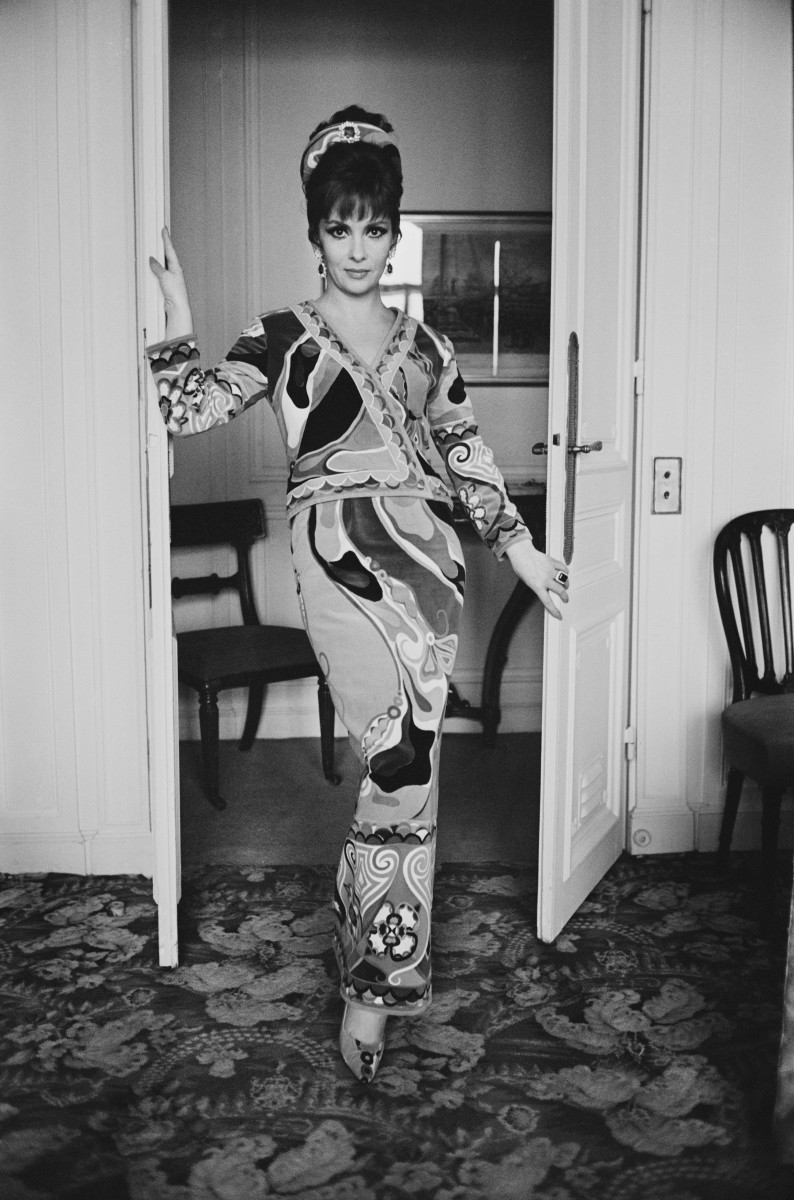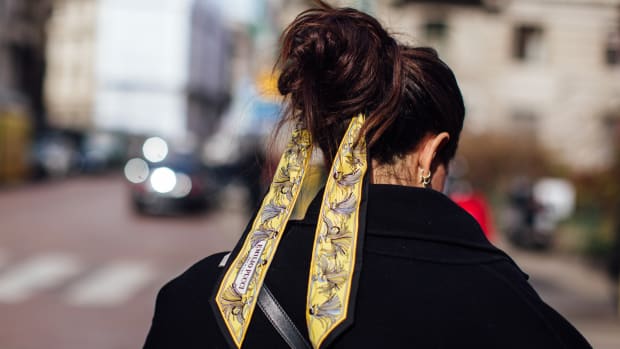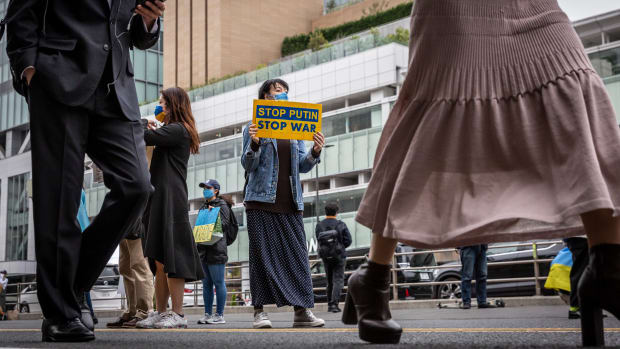"Dopamine dressing" has been anointed one of 2022's most important fashion trends. It’s meant to encapsulate the idea of choosing clothes that encourage joy by way of bright colors, bold prints and
touch-me textures. This is Emilio Pucci's moment.
The Italian brand's cheery ready-to-wear, centered mostly around signature swirling prints, inherently brings a playfulness to everyday dressing — a salve after two years spent in sweatpants.
"Bold joyful prints are exactly what shoppers are gravitating towards in a post lockdown world," says Noelle Sciacca, women's editorial lead at The RealReal. Laura Sophie Cox, a celebrity stylist who has dressed Olivia Rodrigo and Emma Watson adds: "After the past two years, it's so refreshing to see a designer injecting a sense of joy within their silhouettes."
But while there's a long list of labels focused on colorful vacation staples, there's a lot going on behind the scenes at Pucci that makes it particularly poised to own this moment.
The year 2021 was one of transformation that thrust the brand back into the spotlight. First, in June, it was announced that LVMH was taking full ownership of the brand. (The conglomerate acquired a 67% stake in Pucci in 2000). Then, in September, Pucci began to reveal its vision for the future: Camille Miceli, most recently creative director of accessories at Louis Vuitton, would be taking the helm.
Miceli is poised to debut her first collection on April 29 (in Capri, no less), and the brand is primed for a return to the spotlight. As a new era approaches, fashion critic Luke Meagher sees it as an opportunity to "breathe this new life into a brand that, for a lot of young people, isn't on their register. They don't know shit about it except for its colorful prints."
Pucci was founded in 1947; three years later, Emilio Pucci opened his first boutique in Capri. During the '60s, the brand rose to popularity for its colorful, psychedelic prints, splashed across all sorts of sportswear and vacation staples.

Italian actor Gina Lollobrigida wearing Emilio Pucci in 1967.
Photo: Clive Limpkin/Express/Hulton Archive/Getty Images
It re-entered the cultural conversations in the '00s thanks to a stream of buzzy designers taking the helm: Christian Lacroix from 2002 to 2005, Matthew Williamson from 2005 to 2008 and Peter Dundas from 2008 to 2011.
You could expect to see celebrities like Nicole Richie, Jennifer Lopez and Lindsay Lohan dressed in geometric, color-loaded creations from the label. But Pucci wasn't a brand suited to the quiet luxury — championed by Phoebe Philo at Céline — that dominated the 2010s. And after MSGM's Massimo Giorgetti left his creative director role in 2017, Pucci found itself without a designer lead until 2021.
"When it's an in-house team designing, it's hard to build that hype or that excitement because there isn't that person to put weight behind," argues Meagher.
Now, as the industry eagerly awaits Miceli's debut, the brand finds itself in the midst of a larger vintage revival, where interest in aughts fashion can be seen across the runways and joyful Italian fashion houses like Roberto Cavalli, Blumarine and, yes, Pucci come top of mind again. Over the last 12 months, TheRealReal has seen a 437% increase in demand for vintage Pucci and a 42% increase in sales.
"For younger generations stepping into their purchasing power, these are trends they didn't participate in the first time around but now they're excited to experiment with them," says Sciacca of '00s fashion. "For people who did embrace these trends during the early aughts, there's a sense of nostalgia in returning to them. And as we see celebrities and influencers like the Hadids and Jenners wearing these vintage pieces in ways that feel new and exciting, it brings forgotten styles back into the spotlight."
Recommended Articles
According to TikTok, the keywords #upcycling, #vintage and #thrifted have generated more than 26 billion views combined; the #emiliopucci hashtag alone has over 10 million views. And, as users on the platform are shopping for pieces online and digging through their older relatives' closets, they're sharing their finds with a limitless online audience.
"[My dad] had a closet in his house that was just full of women's vintage clothes, and most of it was Pucci — it was the Pucci closet, that's what we called it," says Ivy Getty, an artist, model and the granddaughter of J. Paul Getty, who has taken to sharing her Pucci collection on Tiktok and Instagram. "I would just try stuff on, which didn't fit because I was a child, but I was just always fascinated from then on forward with Pucci."
Because of her early introduction to the brand, Getty now seeks Pucci out on secondhand platforms, keeping an eye out for rare vintage styles. "Nobody ever thinks of eBay like they should," explains Getty. "They have the best items because a lot of the older generation is on eBay, and these are the people that have the iconic pieces."
Leading into Getty's November 2021 nuptials, the bride-to-be threw a '60s-themed party in which her bridesmaids wore coordinated Pucci looks — a mix of what she had previously saved on eBay and new styles found by stylist Carrie Goldberg, with whom she worked for her wedding. "I knew I wanted a themed party, but as soon as we decided on British invasion, kind of mod, Pucci came to my mind," she says.
For a brand like Pucci, there's universality in its modern revival. "Dopamine dressing" isn't reserved for those embracing retrofuturism or for street-style stars: A new era of influencers and celebrities are introducing the brand to an entirely new audience.
Flo Milli posed on Instagram in the brand's tights. Kylie Jenner even got a manicure inspired by the brand's iconic swirls and shapes. Getty borrowed an outfit from the brand for a Sotheby's dinner hosted by A$AP Ferg in November: "He had to greet every table and when he got to my table, he didn't even say hi, he just looked straight at me and was like, 'Pucci?'"
Yet as many shoppers embrace the excitement of occasion dressing once again, the trend cycle races forward at a faster speed than ever. How does a brand so revered for its prints manage to keep the same designs relevant over time?
"It's not easy to continually iterate on an iconic print season after season in a way that feels relevant for more than 70 years," notes Sciacca. "Being without an official creative director seemed to be the best thing for the brand. It gave the design team a chance to experiment." She adds that recent collaborations with Tomo Koizumi and Christelle Kocher helped to reacquaint the public with the brand and drive excitement, even without a buzzy name at the helm.
A successful new era, however, will require a long-term vision that can lift the brand outside of the current moment.
"I'm wondering if [the new collection] will be more accessories-based than it would necessarily be clothing," says Meagher, citing the likes of Maria Grazia Chiuri of Dior, Pierpaolo Piccoli of Valentino and Alessandro Michele of Gucci as predecessors to Miceli. (All similarly worked in accessories before transitioning to the lead positions of their respective brands.) "How many times can you sell a white Pucci muumuu? It's gonna have to be something that’s accessories-based that drives some sort of intrigue and interest. I think Miceli has to bring it back on everyone's minds. It will be intriguing to see if that's actually possible and what it would be through."
"Miceli is a force to be reckoned with," says Sciacca. "While at Dior, she was responsible for introducing the cult-favorite Tribales earrings to the world. I'm hopeful she'll bring that same je ne sais quoi to Pucci and continue to pioneer the newer, fresher aesthetic direction the brand has taken."
As Pucci's past, present and future converge in one flurry of psychedelic swirls, it's Miceli's moment to show the world what a joy fashion can be.
Never miss the latest fashion industry news. Sign up for the Fashionista daily newsletter.



